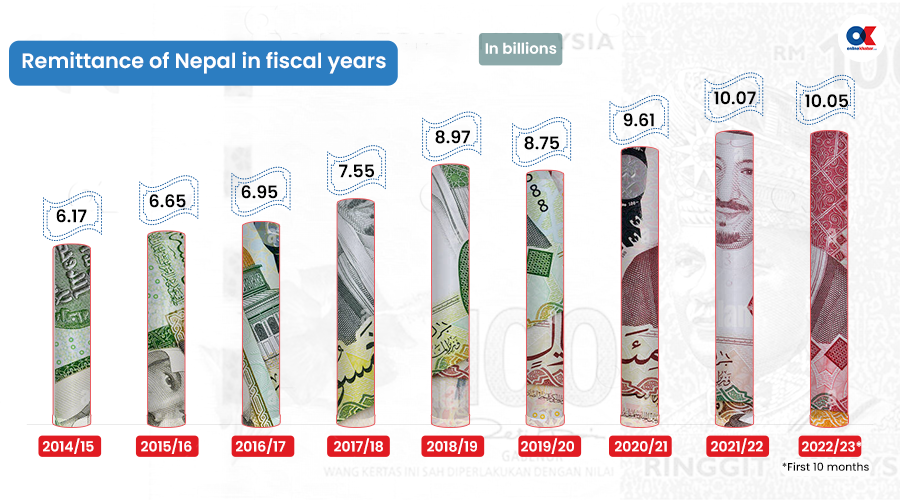
Remittances have become a crucial driver of economic development for various countries, including Nepal. Since the late 1990s, Nepal has witnessed an inflow of remittances, which has played a significant role in stimulating the economy. However, the heavy dependence on remittances has negatively impacted other sectors, resulting in adverse effects on overall economic growth and development. As a consequence, the remittance-driven economy has become a hindrance to Nepal’s progress, creating challenges for sustained prosperity.
According to the data released by Nepal Rastra Bank (NRB), remittance inflows amounted to Rs 689.88 billion in the first seven months of the current fiscal year 2022/23. Owing to its gradual rise, only 3.5 per cent of remittances are used in the productive sector to fuel economic growth, while the rest go to the consumption of household expenditures.
However, it is evident that the emigration of the working population poses challenges to a remittance-driven economy like Nepal, which possesses significant potential for robust growth. The overreliance on remittances has led to detrimental effects on various aspects, such as the productivity of agriculture-based industries, the preservation of farming culture, the management of deficit financing, the functioning of the market economy, the optimal utilization of resources, and the harnessing of the youth demographic dividend. While remittances can serve as a catalyst for economic progress in a developing nation, they alone cannot sufficiently boost the economy without the simultaneous development of other sectors.
Slow poison
The perception of remittance in Nepal resembles a transient euphoria, akin to a drug, lacking sustainable solutions for the economic cycle. As a nation heavily reliant on labour exports, active participation in economic development and local economic support is deemed challenging.
This has led to the unintended consequence of undermining the domestic economy, fostering an import-based false economy. At the close of the fiscal year 2021/22, Nepal imported goods worth Rs 1.92 trillion while exporting goods worth Rs 200.03 billion, increasing the trade deficit.
The weak balance of payments in Nepal can be attributed to substantial imports driven by migrant remittances, as individuals are compelled to work abroad to sustain the economy. Additionally, the lack of government emphasis on promoting self-reliance further exacerbates the issue. Remittances, therefore, cannot be seen as a panacea for holistic growth and development in Nepal; instead, they resemble slow-poisoning drugs that undermine the economic structure.
Lessons from foreign countries

Many countries around the world initially depended on remittances as a key component of their economies but have since recognised the need to diversify and seek alternative sources of income. In 2020, the Philippines received $34 billion from Filipinos working abroad. Following that, authorities cautioned that a remittance-driven economy could leave the country vulnerable to external shocks and volatility. This highlights the importance of pursuing additional revenue streams to ensure stability and reduce susceptibility to external factors.
Following that, the Philippines government started working to reduce the country’s reliance on remittances by investing in its own economy, where strong growth in its manufacturing and tourism sectors has been seen to create jobs and reduce poverty.
In 2020, Mexico received $41 billion in remittances. However, the Mexican government proactively prioritised the development of its economy by making substantial investments in infrastructure, education, and healthcare systems rather than being dependent on a remittance-driven economy. These targeted initiatives have yielded positive outcomes, generating employment opportunities and alleviating poverty levels. Consequently, Mexico has been able to diminish its reliance on remittances as a sole economic pillar.
In 2020, India experienced a substantial influx of over $83 billion in remittances. Nevertheless, the Indian government has actively pursued measures to diminish the country’s dependence on remittances by fostering investments in its domestic economy. Notably, India has witnessed significant growth in its manufacturing and services sectors in recent years, which has contributed to job creation and poverty reduction. By shifting away from a remittance-driven economy, India has been able to diversify its sources of income and promote sustainable economic development.
In Nepal, the question of whether the stagnant political landscape can effectively decrease reliance on remittances by prioritising investments in productive activities for sustainable long-term economic growth and development remains a significant challenge.
Hope not yet lost

Despite the continual challenges of a remittance-driven economy, Nepal has huge capabilities and resources to prosper its economic ecosystem. The withdrawal from the traditional reliance on remittances for an economy is a much-needed phenomenon. Moreover, it helps to discard the languishing political system that has been wasting naturally gifted resources redundantly.
Nepal needs to take an immediate leap forward in order to foster and unlock its potential in various sectors. One such sector is tourism, where enhancing infrastructure and ensuring better security can attract a greater number of tourists. Similarly, in agriculture, providing irrigation facilities, quality seeds, and agricultural extension services can significantly boost the market economy and agricultural productivity. Taking proactive actions in these areas can fuel economic growth, create employment opportunities, and unlock the full potential of Nepal’s resources and capabilities.
In manufacturing, by enticing foreign investment, it can enhance the livelihoods of its workforce diversity, and through hydropower, by selling electricity, it can contribute to the economy.
Additionally, Nepal can lessen its reliance on remittances through massive investments in alternative economic sectors by investing in the fields of the local economy for empowering local farmers and their products, quality education for a skilled workforce, better health amenities to improve healthcare and productivity, and good governance for a stable environment.
Ultimately, the traditional spin-force economy needs urgent reforms to transform a stagnant economic landscape into an encouraging one. To do so, the willpower and attitudinal change of the present political system play a pivotal role in shaping the economy, where it is important for governments to develop conducive policies that slow down the reliance on remittance-driven economies and promote sustainable economic growth.
Nevertheless, it is the collective responsibility of the local economy, private sector and government sector to enhance the growth of a country’s economy. Thus, it is crucial to cash in on the opportunity costs by utilising the resources, which are blessed by nature itself.






















